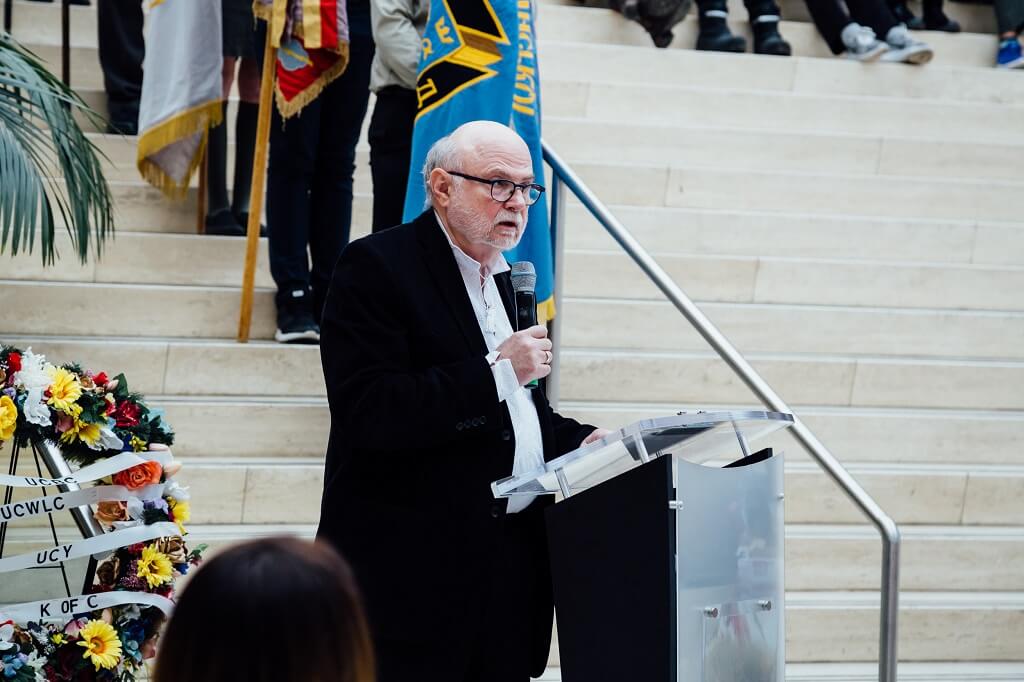Marco Levytsky, Western Bureau Chief
Canadians too were involved in the international cover-up of the Holodomor when millions of Ukrainians were starved to death by Soviet authorities in 1932-33, said the keynote speaker at the commemoration of the 85th anniversary of that genocide, held at Edmonton’s City Hall, November 24.
Jars Balan, Director of the Canadian Institute of Ukrainian Studies at the University of Alberta, focused on two such Canadian accomplices in the disinformation campaign that the Soviet regime effectively used to deflect attention away from the ruthless extermination policy that the Kremlin was pursuing in tandem with its forced collectivization drive at the commemoration, which was organized by the Ukrainian Canadian Ukrainian Congress, Edmonton Branch.
The first was a journalist named Pierre van Paassen who while working for the Globe as their European correspondent, was dispatched to the Soviet Union in May 1932 on a fact-finding mission ‘that he proclaimed would provide a fully objective account of what was happening under Stalin’s much ballyhooed Five-Year Plan. In all, he wrote 21 articles about his first trip to the Soviet Union, eight for the Globe and the remainder for the Toronto Star, which he suddenly jumped to after an obvious parting of ways with his Globe editors, who clearly felt that his accounts were too ‘soft’ on the regime in contrast with other reporting being done about conditions in Communist Russia.”
In one of his stories, “Van Paassen claimed there was no actual famine, while asserting that government policy was to blame in that it moved too fast to collectivize agriculture and requisitioned too much grain. No mention was made of the role of the Bolshevik leadership in creating the disastrous conditions, nor did it show that the Kremlin knew exactly what it was doing in the war that it had openly declared against the peasantry in general, and especially the farmers of Ukraine.”
The second Canadian journalist who also helped to create a distorted picture pf what was really happening in the Soviet Union at this critical time was an Irish-born immigrant named Frederick Griffin, who toured the USSR during this period.
“In all, Griffin wrote more than forty articles about his whirlwind eight-week trip through the Soviet Union, many of them enthusiastically portraying the great progress being made in modernizing agriculture and developing industry. Although he also made some critical observations about “problems” with the Five-Year Plan, on the whole he characterized it as a tremendous success. Almost no attention was paid to the enormous human cost of what was frequently described as the Soviet “experiment” (in which Ukrainians and others were treated like laboratory rats), and the spin in his accounts was distinctly positive and optimistic about future of the USSR,” said Balan.
In one particular article published in the Toronto Star on 8 August 1932, Griffin described “a tremendous Ukrainian feast that he was feted with in the Donbas, undoubtedly washed down with generous amounts of horilka. What makes the latter piece especially offensive is that Griffin scarcely makes any reference to the grim food situation in the country, though he undoubtedly must have been aware of it, if only from the gaunt features of people that he would have seen in passing in his travels,” he added.
“What is important to understand about the writings of not only Van Paassen and Griffin, but many other Western journalists, is that on the key issue of the famine they essentially and uncritically parroted the narratives promoted by the Soviet regime. Namely, that it was a terrible human ‘tragedy,’ which the regime ostensibly tried to mitigate it when it became aware of what was going on in the countryside; that it was in no small measure caused by the peasants themselves, who worked to sabotage the forced collectivization drive, killing their livestock and burning their crops; that it was the result of local officials over-zealously applying government grain collection policies; and that was in part attributable to drought conditions and a crop failure attributable to natural causes.” continued Balan, adding that today’s Russian government – “again with the help of sympathizers and gullible individuals in the West – continues to obfuscate the truth about its scale and genocidal nature.”
“We need to remember today that at this very moment, Russia is waging a war in Ukraine, having first militarily occupied and annexed the Crimea peninsula by stealth, and then destabilized and invaded two southeast provinces of Ukraine using both regular and proxy Russian forces.
“Accompanying this brazen act of aggression and violation of international law, Russia is also conducting a relentless, well-financed and sophisticated disinformation campaign intended to undermine Ukraine’s right to a sovereign existence and to reassert the old Tsarist and Soviet narratives of Ukraine’s history… Today, we are all witness to a new campaign conducted by the Kremlin to deny, disguise, and dissemble what it has been doing in and to Ukraine in a renewed effort to restore its political, cultural, economic and linguistic control over Ukrainians,” he said.
“If there is something to be learned in marking the 85th anniversary of the Holodomor, it is that the story of the Ukrainian famine not only remains relevant, it serves as a cautionary tale to those of us today who are again witnessing both naked Russian aggression being directed against Ukraine but also a concerted disinformation campaign to muddy the waters about what Russia has done and is doing in Crimea and in southeast Ukraine. Those of us who believe in democracy and the importance of a free press, need to be aware of just how easily the former can be subverted and the latter manipulated in giving equal weight to the lies and distortions of propaganda,” noted Balan.
Other speakers included Edmonton Centre MP Randy Boissonault, speaking on behalf of the federal government; Lorne Dach – MLA, Edmonton-McLung on behalf of the provincial government; City Councillor Jon Dziadyk and Alexandra Datsyk, Vice President, UCC Edmonton Branch.
The commemoration opened with a Prayer Service conducted by Bishop David Motiuk, Ukrainian Catholic Eparch of Edmonton concelebrated with clergy from the Edmonton Eparchy and the Western Canadian Eparchy of the Ukrainian Orthodox Church of Canada. Responses were sung by by Kappela Kyria Choir under the direction of Dr. Melanie Turgeon.
Two survivors of the Holodomor, Natalka Talanchuk and Leonid Korownyk, were also present. Korownyk read a poem he himself had written entitled “Hell Like Holodomor“ .
Students representing the St. Matthew and St. Theresa Ukrainian Bilingual School Choirs sang “Dry Tears- Holodomor through the eyes of children ”. The song was written and will be conducted by Natalia Onyschuk from St. Matthew’s and accompanied by Iryna Tarnawsky.
The song was composed on the 80th anniversary of Holodomor.The intent was to teach students about Holodomor by looking at events through the eyes of children – school-aged children who were innocently living their daily lives.The chorus reflects the voices of present-day children who will one day hold the future in their hands.
MC for the commemoration was Katrusia Pohoreski.
Flag bearers representing various organizations line up at the side of the staircase. This included Members of the Ukrainian Youth Association CYM, the Ukrainian Youth Association Plast and the Ukrainian Orthodox Youth of Canada CYMK.
Following the ceremony, participants exited the building to lay wreaths at the monument to victims of the Holodomor – the first such monument erected in the world.
Share on Social Media




































